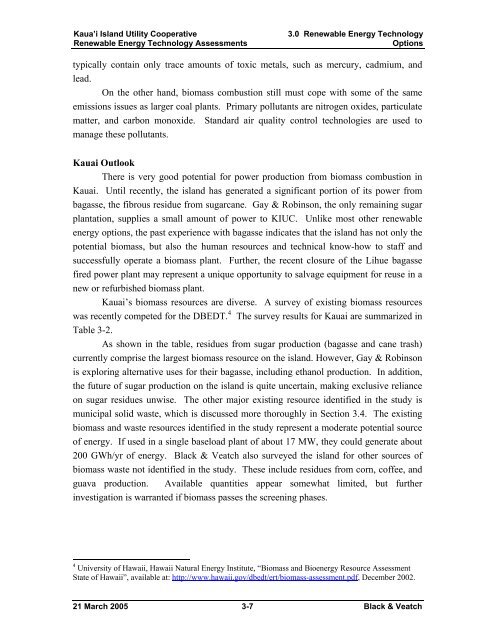Renewable Energy Technology Assessments - Kauai Island Utility ...
Renewable Energy Technology Assessments - Kauai Island Utility ...
Renewable Energy Technology Assessments - Kauai Island Utility ...
You also want an ePaper? Increase the reach of your titles
YUMPU automatically turns print PDFs into web optimized ePapers that Google loves.
Kaua’i <strong>Island</strong> <strong>Utility</strong> Cooperative<br />
<strong>Renewable</strong> <strong>Energy</strong> <strong>Technology</strong> <strong>Assessments</strong><br />
3.0 <strong>Renewable</strong> <strong>Energy</strong> <strong>Technology</strong><br />
Options<br />
typically contain only trace amounts of toxic metals, such as mercury, cadmium, and<br />
lead.<br />
On the other hand, biomass combustion still must cope with some of the same<br />
emissions issues as larger coal plants. Primary pollutants are nitrogen oxides, particulate<br />
matter, and carbon monoxide. Standard air quality control technologies are used to<br />
manage these pollutants.<br />
<strong>Kauai</strong> Outlook<br />
There is very good potential for power production from biomass combustion in<br />
<strong>Kauai</strong>. Until recently, the island has generated a significant portion of its power from<br />
bagasse, the fibrous residue from sugarcane. Gay & Robinson, the only remaining sugar<br />
plantation, supplies a small amount of power to KIUC. Unlike most other renewable<br />
energy options, the past experience with bagasse indicates that the island has not only the<br />
potential biomass, but also the human resources and technical know-how to staff and<br />
successfully operate a biomass plant. Further, the recent closure of the Lihue bagasse<br />
fired power plant may represent a unique opportunity to salvage equipment for reuse in a<br />
new or refurbished biomass plant.<br />
<strong>Kauai</strong>’s biomass resources are diverse. A survey of existing biomass resources<br />
was recently competed for the DBEDT. 4 The survey results for <strong>Kauai</strong> are summarized in<br />
Table 3-2.<br />
As shown in the table, residues from sugar production (bagasse and cane trash)<br />
currently comprise the largest biomass resource on the island. However, Gay & Robinson<br />
is exploring alternative uses for their bagasse, including ethanol production. In addition,<br />
the future of sugar production on the island is quite uncertain, making exclusive reliance<br />
on sugar residues unwise. The other major existing resource identified in the study is<br />
municipal solid waste, which is discussed more thoroughly in Section 3.4. The existing<br />
biomass and waste resources identified in the study represent a moderate potential source<br />
of energy. If used in a single baseload plant of about 17 MW, they could generate about<br />
200 GWh/yr of energy. Black & Veatch also surveyed the island for other sources of<br />
biomass waste not identified in the study. These include residues from corn, coffee, and<br />
guava production. Available quantities appear somewhat limited, but further<br />
investigation is warranted if biomass passes the screening phases.<br />
4 University of Hawaii, Hawaii Natural <strong>Energy</strong> Institute, “Biomass and Bioenergy Resource Assessment<br />
State of Hawaii”, available at: http://www.hawaii.gov/dbedt/ert/biomass-assessment.pdf, December 2002.<br />
21 March 2005 3-7 Black & Veatch
















